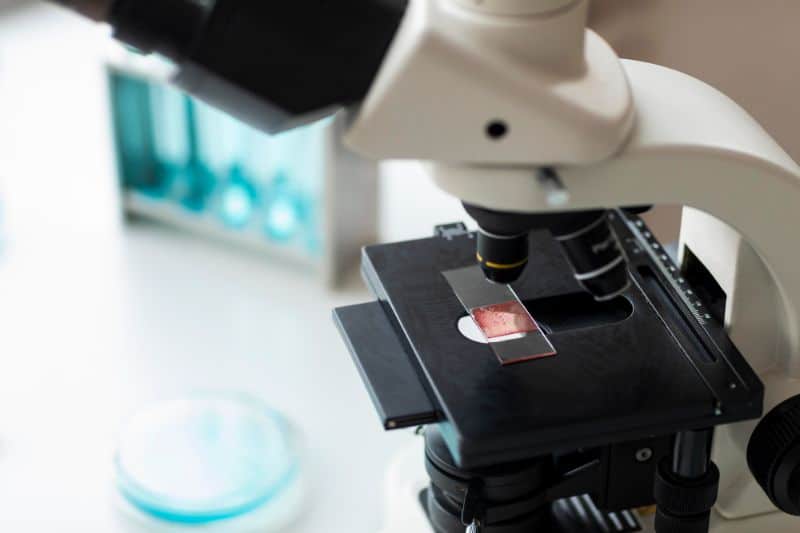SKIN CANCER
Biopsy
What Is A Skin Biopsy And Why Is It Performed?
Lorem ipsum dolor
A skin biopsy involves the removal of a skin sample, typically performed under local anaesthetic to diagnose skin conditions. It’s essential for identifying diagnostic clues not visible to the naked eye, especially for confirming or ruling out skin cancer.
During a skin check, if Dr. Tina Fang notices a suspicious lesion, she may recommend a skin biopsy to obtain a small sample for further testing. Skin biopsies are routine procedures and can be performed quickly and comfortably in the clinic with local anaesthesia. The collected samples are sent to a specialised skin pathology laboratory, where a histopathologist examines them to provide an accurate diagnosis. This confirmed diagnosis is crucial in helping us develop the most appropriate treatment plan for you.


Key Information
What are the types of skin biopsies?
- Punch Biopsy: Ideal for obtaining a full-thickness skin sample, using a circular blade, often for suspected skin cancer or inflammatory skin diseases.
- Shave Biopsy: Suitable for superficial lesions, removing a skin layer without stitches, but may not confirm invasive disease.
- Incisional and Excision Biopsy: This procedure involves removing larger or entire lesions, particularly when deeper tissue analysis is needed or complete removal is aimed for. This type of biopsy is necessary when we suspect a lesion might be melanoma. It allows the histopathologist to study the full depth and margins, providing us with a definite diagnosis. Stitches are generally required, and the removal of stitches will depend on the area being operated on.
When will I know the result?
Your histology result will generally take 7 days to come back. You will receive a call from us with the results of your biopsy, even if they are benign. This ensures no lost follow-ups and keeps you well-informed. If you do not receive a call from us, please contact us at 07 3472 7477 or via our website.
What are the potential complications of a skin biopsy?
Complications are rare but can include bleeding, infection, nerve injury, scarring, persistence or recurrence of the lesion, anaesthetic reactions, and wound breakdown. The risk varies with the biopsy type and the individual's health status.
Aftercare Instructions for Biopsy
After a skin biopsy, it’s important to follow specific aftercare instructions to ensure proper healing and prevent infection. Here’s a summary of the key points:
- Keep the Wound Clean and Dry: For the first 24 to 48 hours after the biopsy, it’s crucial to keep the wound clean and dry. This helps to prevent infection and supports the healing process.
- Dressing Care: If the dressing becomes soaked with blood or water, carefully replace it with a clean, dry band-aid. It’s essential to keep the wound covered, especially in the initial stages of healing, to protect it from bacteria and other contaminants.
- Monitor for Signs of Infection: Pay close attention to the biopsy site for any signs of infection. These can include increased redness, swelling, warmth, pain, or discharge. Infections can significantly delay healing and may require treatment, so it’s important to catch them early.
- Contact the Clinic if Necessary: If you notice any signs of infection or if you have any concerns about the biopsy site, do not hesitate to contact the clinic where the biopsy was performed. 07 3472 7477 or via our website.
Skin Cancer Treatments
Skin Cancer Checks
Biopsy
Cryotherapy
Excisions
Photodynamic Therapy
Topical Agents


Advanced Certificate of Aesthetic Medicine
Healthcert

Fellowship of the Royal Australian College of General Practitioners 2019

Skin Cancer College Australasia
Advanced Skin Surgery
Your Trusted Skin Cancer Doctor
Dr Tina has been trained extensively in skin cancer medicine and surgery.
Dr Tina Fang is a qualified female Skin Cancer Doctor in Brisbane, known for her extensive knowledge in both skin cancer and aesthetic medicine. She works across three large specialised skin cancer clinics that check thousands of skins every year, and has been working full time in dedicated skin cancer and cosmetic clinics since 2019.
After completing training and qualifications in dermatoscopy, advanced skin cancer surgery, and advanced aesthetic medicine, Dr Tina offers comprehensive skin checks and skin cancer management. She thoroughly examines the skin for any potential issues, evaluating each detail with a keen eye, and provides clear guidance and appropriate treatment recommendations informed by years of experience and the latest medical best practice.
In addition to skin cancer care, Dr Tina is passionate about hair loss treatments, cosmetic injectables, and cosmetic mole removal, offering a holistic approach to prevention, early detection, and aesthetic treatments.
Begin your journey now
Individualised assessment and professional care with Dr Tina Fang
Call us on 07 3472 7477